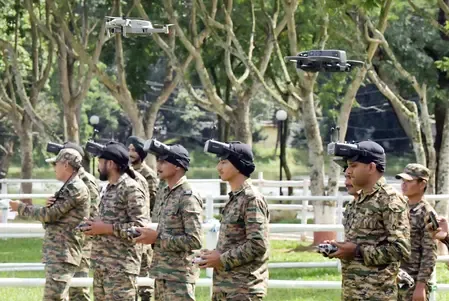Is 'SAKSHAM' India's New Eye in the Sky to Counter Aerial Threats?

Synopsis
Key Takeaways
- SAKSHAM enhances aerial defense capabilities.
- Indigenous development aligns with Aatmanirbhar Bharat.
- Real-time detection and neutralization of drones.
- Comprehensive airspace control up to 3,000 metres.
- AI-driven technologies for future combat scenarios.
New Delhi, Oct 9 (NationPress) Approximately five months after Operation Sindoor demonstrated the capabilities of the Indian security forces, particularly in countering around 400 drones launched by Pakistan aimed at Indian defensive positions and civilian targets, the Indian Army has embarked on the procurement of an indigenous ‘SAKSHAM’ Counter Unmanned Aerial System (UAS) Grid System.
As per defence officials, this advanced system is crafted to detect, track, identify, and neutralise hostile drones and unmanned aerial systems in real time, ensuring total airspace security throughout what is now termed the Tactical Battlefield Space (TBS). This expanded domain encompasses the Air Littoral, which covers the airspace up to 3,000 metres (10,000 feet) above ground level.
It is crucial to highlight that the demand for a robust counter-UAS strategy became evident during Operation Sindoor, where hostile UAS activities underscored the necessity for rapid detection, coordinated responses, and airspace management that transcends conventional ground boundaries.
“The Indian Army has since transitioned its operational framework from the former Tactical Battle Area (TBA) to the broader Tactical Battlefield Space (TBS), acknowledging that future conflicts will occur not only on land but also within the air littoral directly overhead,” an official remarked.
This innovative strategy guarantees that the airspace up to 3,000 metres above ground remains under the control of ground forces, facilitating unimpeded movement for friendly aerial assets while simultaneously detecting, tracking, and neutralising adversarial drones or aircraft.
Significantly, in contemporary warfare—especially noted in the Russia-Ukraine war, Israel-Palestine conflicts, and during Operation Sindoor, where Pakistan launched nearly 400 drones (all of which were neutralised by security forces)—modern battles have increasingly incorporated drones for reconnaissance and offensive measures.
Conceived as a high-tech, modular Command and Control System, SAKSHAM, short for Situational Awareness for Kinetic Soft and Hard Kill Assets Management, has been developed in partnership with Bharat Electronics Limited (BEL), Ghaziabad.
SAKSHAM is designed to deliver integrated situational awareness for counter-UAS management via an effective CUAS network grid across the Tactical Battlefield Space.
It aims to integrate data from both friendly and enemy UAS, CUAS sensors, and soft/hardkill systems onto a unified GIS-based platform.
Moreover, it will provide automated decision support and real-time visualization for field commanders, offering a modular, scalable, and adaptable architecture to meet evolving UAS threats.
Among its major features, it incorporates AI-enabled threat analysis for predictive identification and expedited decision-making.
The system is entirely indigenous, embodying the government's vision of ‘Aatmanirbhar Bharat’ in defence technology.
Engineered and developed by BEL, this system integrates AI-driven fusion technologies for future combat scenarios, ensuring scalability and upgradability as threat landscapes change.
To facilitate swift deployment, the project has been sanctioned under the Fast Track Procurement (FTP) route, with plans for rollout to all field formations within the next year.









